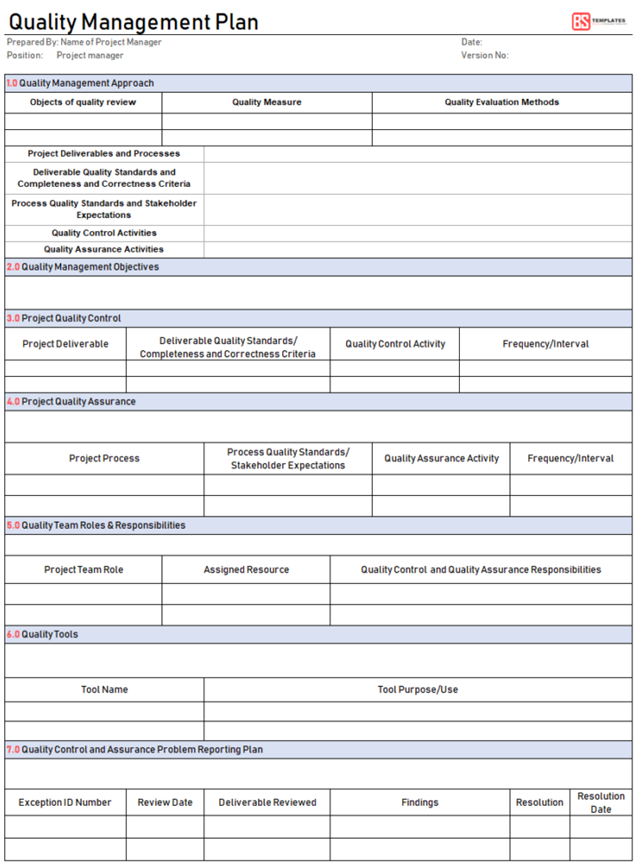It is widely understood that planning is the most critical phase of a project. It is at this stage that information is collected and analysed, goals are set, and the overall project plan is developed. An essential part of the overall Project Plan is the Quality Management Plan. It is often the project manager who has overall responsibility for driving and developing this plan but as a project team member or participant, you will likely be required to contribute.
Being the initial stage in a project, the planning stage involves the identification of project stakeholders and their interests, needs, and requirements. The success of the project is defined by how well these needs, criteria, and requirements are addressed in the project. Thus, it is a must that in the development of the Quality Management Plan, the specifications, quality requirements, and quality criteria for different aspects and stages of the project and project deliverables are decided and agreed on.
In this topic, you will learn how to contribute to project quality planning, specifically:
- determining quality requirements of project stakeholders
- identifying quantifiable quality criteria for project deliverables
- locating and interpreting policy and procedures for project quality
- developing quality requirements in the project plan and processes.

The initial phase of quality management requires the development of a project quality management plan which entails the identification of the quality requirements and guidelines that the project processes and products must comply with. It is in this phase that the project team gets in touch with relevant project stakeholders and gathers data relevant to quality requirements and criteria.
Quality requirements and project stakeholders
Quality requirements are the specifications of the quality of products, services, processes, or environments that are involved in the project. These help in the assessment of the project’s compliance and fulfilment of the project requirements.
Quality requirements are:
- the expectations of the customer for quality
- the internal processes and the attributes of products that indicate whether the quality factors are satisfied or not.
Quality requirements are often shaped by what the project stakeholders want and need. Since stakeholders can have different interests and needs, it can be tricky for the project manager and team to figure out what exactly those requirements are. They must find a sweet spot between meeting the needs of the important stakeholders and sticking to the project's goals and standards.
Stakeholders, on the other hand, are individuals, groups, or organisations who may affect, be affected by, or perceive themselves to be affected by a decision, activity, or outcome of a project. They are comprised of persons and organisations whose interests may be positively or negatively affected by the execution or completion of the project. They may also use influence over the project and its deliverables. Stakeholders may be at different levels within the organisation and may possess different authority levels or may be external to the organisation performing the project.
Stakeholders that are relevant to the project might include:
- business partners
- customers and users
- internal parties
- consultants
- performing organisations
- sponsors
- subject matter experts
- government regulators
- external parties
Communicating with stakeholders
There are some common methods to communicate with stakeholders. Note that a small project might only use one or two of these, while a large project might use most or even all of them.
Click on each method to read more about it.
Stakeholder requirements analysis
Once you have identified the key stakeholders of your project, you can then carry out a stakeholder analysis to determine their needs. These needs will vary among stakeholders, and all of these differing needs must be considered and managed. How you will engage all of your stakeholders must be planned very early on in the project.
Determining stakeholder requirements involves not just collecting the information but also prioritising it into what is most important, what is non-negotiable and so on.
To determine the quality requirements of project stakeholders, your project team must go into a stakeholder requirements analysis.
1. Eliciting requirements
No stakeholder requirements analysis can take place without the relevant data first; that is, the quality requirements themselves should first be elicited from the project stakeholders.
In order to acquire information about the project stakeholders’ needs and demands relevant to project quality, your project manager should communicate with the stakeholders. There are several ways by which you can gather the essential information your project team needs.
As discussed earlier, the following are the most common methods of communicating with stakeholders:
- Letters or emails
- Surveys or questionnaires
- Forums
- Focus groups or workshops
- Interviews
2. Analysing requirements
The requirements gathered from the stakeholders must be analysed to ensure that they are clear, complete, and relevant. Requirements must be actionable, measurable, documented, testable, traceable, related to identified business needs or opportunities, and documented. Once an issue or shortfall is encountered, it must be resolved immediately.
To make the analysis easier, you may consider categorising the requirements into the following:
- Functional requirements – These requirements define how a product/service should function.
- Operational requirements – These are the requirements that define the operations that must be carried out.
- Technical requirements – These pertain to the technical issues that must be taken into consideration to successfully develop the product or implement the process.
- Transitional requirements – These refer to the steps needed to implement the new process or product smoothly.
3. Requirements modelling
This stage entails the documentation of collected data in different formats according to existing organisational policies and procedures. The data collected are documented and transformed into a variety of formats. These formats can be:
- User cases – the service or product is put in a real-life context where it is being utilised
- User stories – a scenario technique where the product or service with the developed requirements is considered from the end user’s perspective
4. Reviewing and retrospective
This final stage in the stakeholder requirements analysis is conducted to evaluate the requirements developed and whether there is any need for improvements. Further, it also entails an assessment of the process your team has undertaken in collecting quality requirements.
Determining quality requirements of project stakeholders
Even though communicating with project stakeholders is primarily the responsibility of the project manager, developing the quality requirements of project stakeholders is not the project manager’s task alone. As a member of the project team, you may be assigned to develop quality requirements from existing documentation of the communication with project stakeholders.
To get an idea of how stakeholder interests and needs can relate to the stakeholder’s quality requirements, refer to the table below, which outlines quality requirements that correspond to the various interests and demands of the relevant stakeholders.
| Stakeholder | Specific interest in the project | Example needs/quality requirements |
|---|---|---|
| Project sponsor or client | Owner/funding source of the project |
|
| Project manager | Responsible for ensuring the delivery of the project |
|
| Project team | Responsible for delivery of tasks/services | Sufficient information, support, and resources to complete tasks and responsibilities as planned. |
| Contractors | Responsible for delivery of specific tasks/services | Sufficient information, support and resources to complete tasks and responsibilities as planned. |
| Suppliers | Provides goods and services to support the project | Clear specifications and expectations regarding goods and services to be supplied, including clear and reasonable timeframes and payments. |
| The end user or customer | Benefits from the end-product of the project | Requires a product that is ‘fit for purpose’ — does the job it is supposed to do. The product has added value, such as style and aesthetics, or works better than expected. |
| Regulatory bodies | Provides standards/laws regarding the quality of the project | Both the products/services delivered and the processes used to get there meet legal and quality standards. |
| Senior executive or management | Corporate governance of the project | Project processes and outcomes are met as required. May have additional requirements, such as showcasing the company’s innovation or upskilling workers. |
Check your understanding
Respond to the following three questions to check your understanding of this topic.
Click on the dots to navigate through the questions.

Another part of the planning phase is deciding the criteria that will be used to judge the conformance of project deliverables to the organisation and project team’s desired quality. You and your project team must take the time to develop and agree on the quality criteria that will be applied to deliverables.
Quality criteria and project deliverables
Project deliverables are essentially the results of the project or processes in the project.
A project deliverable can be of many kinds, such as:
- Document
- Product
- Results
- Equipment
- Software
- Approval
Project deliverables can be defined by considering the following questions:
- What is the project trying to achieve?
- What is the purpose, goal, or result that the customer wants once the project closes?
- What are the constituent parts of the project goal?
- What is the form and function of each of these constituent parts?
- How important is this part of the overall project?
- How will it be possible to create this part?
- What is the cost of production/acquisition of this part?
- How long will it take to produce/acquire this part?
Quality criteria, on the other hand, are the detailed specifications of the outputs and outcomes to be delivered by the project. They must be achieved before product acceptance and project sign-off can occur.
Quantifiable quality criteria
Quality criteria must be clearly defined in such a way that anyone can validate them — anyone can tell objectively through quantifiable measures whether quality requirements have been met. One way to do this is to develop criteria using the SMART criteria.
SMART criteria
The SMART acronym is an incredibly powerful goal-setting tool against which you can check your team’s planned goals, objectives and tasks to ensure that they are optimised, inspiring and achievable.
Quality criteria are SMART when they are specific, measurable, attainable (or achievable), relevant, and time-based (or time-bound):
| S | M | A | R | T |
|---|---|---|---|---|
| Specific | Measurable | Achievable | Relevant | Time-based |
| Vague and subjective terms such as ‘good’, ‘awesome’, and ‘user-friendly’ are open to interpretation, so deciding if these qualities have been achieved relies on personal opinion. Specific criteria must be more concrete than this and should be answerable by a ‘yes’ or ‘no’.
Specific quality criteria should answer the following questions of:
|
When criteria are measurable, they are quantifiable by metrics or numbers. The numbers can relate to quantity or speed, for example, how many phone calls are answered per minute or how many items are packed in each box. It can also relate to errors, for example, less than five spelling errors per 100 pages.
Specific requirements might relate to measurements, such as the minimum, maximum, or exact resolution or pixels for photographs or the thickness of roof beams in a building. Quality criteria that are measurable should answer the following questions:
|
Quality criteria must be realistic and able to be achieved within the project parameters and constraints — time, cost, and available knowledge and resources. Quality criteria are not aspirational goals to aim for but the baseline of what must be achieved. It is ultimately the project manager’s responsibility to decide what is actually achievable. Useful tools for this include estimation (based on previous experience of similar projects and/or input from experts) and negotiation and compromise with stakeholders.
Quality criteria must also be agreed upon by all parties. When the quality criteria are recorded in the Quality Management Plan, they must have signature approval from both management and the client/sponsor and other key stakeholders as required by the project governance. |
Quality criteria are relevant when they contribute to the overall goals of the project. When deciding whether criteria are relevant, they should be considered in the wider context — do they align with the higher-level requirements of the project outputs, such as purpose and function? Do they align with current industry standards and trends, the economic and political climate, and internal organisational policy?
Also, consider whether each criterion makes sense in relation to the other criteria. Are there any conflicts or competing priorities/dependencies between quality criteria? |
Sometimes called ‘time-bound’, this requires that the quality criteria answer the question of ‘when’. When quality criteria are defined, they are incorporated into the project schedule. At this stage, target dates for milestones and deadlines are added to ensure that all requirements are met in a timely manner. |
Case Study

Improving Customer Service Efficiency
Company: XYZ Electronics
Background: XYZ Electronics, a leading provider of consumer electronics, was facing challenges in meeting customer service demands efficiently. Complaints about long wait times for support and unresolved issues were on the rise, affecting customer satisfaction levels and ultimately impacting sales.
| SMART Goals | Quality Criteria |
|---|---|
| Specific | XYZ Electronics aims to reduce average customer service wait times by 50% within six months. (At the moment, the average wait time is 50 minutes. This needs to be reduced to 25 minutes.) |
| Measurable | The company would track average wait times for customer service inquiries using a ticketing system and measure progress weekly. |
| Attainable | To achieve this goal, XYZ Electronics planned to implement a new customer service software system with automated ticket routing and improved knowledge base resources for support agents. |
| Relevant | Improving customer service efficiency is directly tied to enhancing overall customer satisfaction and loyalty, which aligns with XYZ Electronics' mission of providing exceptional service. |
| Time-based | The goal to reduce wait times by 50% was set to be achieved within six (6) months, providing a clear timeframe for implementation and evaluation. |
Quantifiable quality criteria may also be adapted from already existing external and internal documents, such as:
Click on the following document types to read more about each.
Reading
Refer to the following websites for more information on quality criteria that apply to each industry:
- International Organization for Standardisation (ISO) - for a range of standards recognised and implemented globally
- Standards Australia – for a range of standards approved and utilised in Australia
Watch
Watch the following 2-minute video to have a better understanding of ISO standards:
Identifying quantifiable quality criteria for project deliverables
Although your project manager is primarily responsible for developing the quality criteria overall, you may be required to contribute as part of the project team. In some teams, the quality criteria may be developed together as a team exercise, such as in a workshop. You can contribute by sharing ideas, asking questions, playing ‘devil’s advocate’, and working together to identify quantifiable quality criteria.
Depending on the type of project being undertaken and your role in the project, you may be responsible for identifying the criteria that relate specifically to your area of expertise. For example, if your role in the project is to design doorknobs, you may be asked to contribute by identifying the criteria that apply specifically to the doorknobs. Other members of the project team would contribute criteria that relate specifically to their area of expertise, such as the doors, the paint and so on.
The first step in determining quality criteria for project deliverables is to collect and prioritise the quality requirements of relevant stakeholders. The quality requirements you have initially identified may serve as a guide in determining the criteria by which the project deliverables’ quality will be checked against.
The relevant stakeholders’ needs and interest in the project quality may also be considered when identifying criteria that your project deliverables must comply with. Specifically:
- The client/sponsor – What do they want?
- Internal organisational management – Which organisational policies and priorities impact the project outcomes and processes?
- Regulatory bodies – Which legislative and industry standards must the deliverables conform to? Each industry has various organisations, bodies, and associations that provide specific information.
Other methods for developing quality criteria include the following:
Click on the methods to read more about each.
Check your understanding
Respond to the following four questions to check your understanding of this topic.
Click on the dots to navigate through the questions.

Ultimately, the responsibility of ensuring quality compliance at the project level and executive management at the organisational level sits on the project manager. However, you may be tasked with locating and interpreting quality policies and procedures as part of your project role. Therefore, it is crucial that you are aware of this aspect.
Once you have accessed and sourced the relevant policies and procedures that apply to the project you are undertaking, all activities and decisions regarding quality management planning must be consistent with those policies and procedures. All members of the project team must take personal responsibility for complying with them.
The quality management, quality assurance, and quality control activities to be embedded in the project plan and processes must be aligned with the policies and procedures.
Policies and procedures that must be adhered to include:
- legislative requirements, for example, local, state, and federal laws and regulations such as environmental or work health and safety legislation
- relevant industry standards, such as Australian standards, specific industry standards, professional standards, and codes of practice
- Australian and international standards relating to quality which are often used to determine quality objectives
- organisational policies, processes and procedures, company production standards and/or specific management directives
- your organisation’s key performance indicators (KPIs)
Each task in a project will not only need to satisfy the established quality criteria but also comply with the relevant policies and procedures. Depending on the task, several types of quality policies and procedures could apply, such as the following:
Click on each to read more about them:
Sources of policies and procedures
To find the appropriate quality policies and procedures that apply to a specific project, consider the following sources.
Click on the headings to read more about each source.
The ISO 10006 standard provides guidelines for quality management in projects. It covers the following main areas:
- quality management systems in projects
- management responsibility
- resource management
- product realisation
- measurement, analysis, and improvement.
Other specific guidelines may be embedded in your organisational policies and procedures and in the specific project documentation (e.g. quality management plan).
Reading
Explore the information about ISO standards at Standards Australia.Watch
Watch the following 1-minute video to better understand how Australian Standards provide procedures and guidelines for safe practices in every aspect of life:

Primarily it is the project manager’s responsibility to develop the overall project plan, including the quality management plan. The quality management plan defines standards and guidelines for project processes. It integrates the project's quality requirements and criteria for deliverables, ensuring compliance.
As a member of a project team, regardless of your role, you will be required to contribute to the development of the quality management plan.
You may also have contributed by researching and identifying the organisational policies and procedures, legal requirements, and required industry standards that apply to the project. Once the quality standards and requirements, as well as applicable policies and procedures, are defined, they must be documented in the quality management plan and embedded into the project processes.
Quality management plan
All the quality standards and guidelines you have learned to develop and identify thus far must be laid out in your project’s quality management plan to ensure that these quality requirements are being met. The developed quality requirements, criteria, and standards must be documented in the quality management plan. More specifically, your project’s quality management plan should include the following:
- quality objectives and definitions
- quality criteria that must be met
- quality standards that must be achieved
- policies and procedures that must be complied with
- any legislation that must be complied with
- levels of performance required
- quality management tools and methodologies
- quality assurance processes
- quality control processes
- authorisations and responsibilities (including the identification of experts to conduct audits/check quality throughout the project)
- change request processes that could impact the quality
- continuous improvement mechanisms
- tools, procedures, and techniques to be used.
Most organisations will have a standard approved format for developing the project plans. You might contribute to preparing the documents in several ways, depending on the project tasks that have been assigned to you. A common practice is to divide up the plan and assign various tasks to the members of the team. You might have individual responsibility for certain aspects or work in pairs or groups to complete each section. The process will involve collating the quality requirements established earlier and copying them into the project plan template.
The project quality management processes and procedures are carried out according to this plan.
Below is a sample Quality Management Plan template from Prince2™:

Once the project plan is complete, it is sent for approval and sign-off by higher management and, in some cases, by the sponsor or client.
Developing quality requirements in project processes
As you can see in the quality management plan template above, standards for planning, quality assurance, and quality control must be specified. Those criteria and standards will serve as the benchmark for performing the different activities involved in that process.
Below is a table of the commonly performed activities for each of the three processes in quality management and sample quality requirements for each:
| Quality Processes | Common Quality Activities | Sample Quality Requirements |
|---|---|---|
| Quality planning |
|
|
| Quality assurance |
|
|
| Quality control |
|
|
Remember that the quality requirements in the project plan and processes that you contribute to identifying must be specific and relevant to the project.
Check your understanding
Use the following questions to check your knowledge regarding this topic:
Click on the dots to navigate through the questions.
